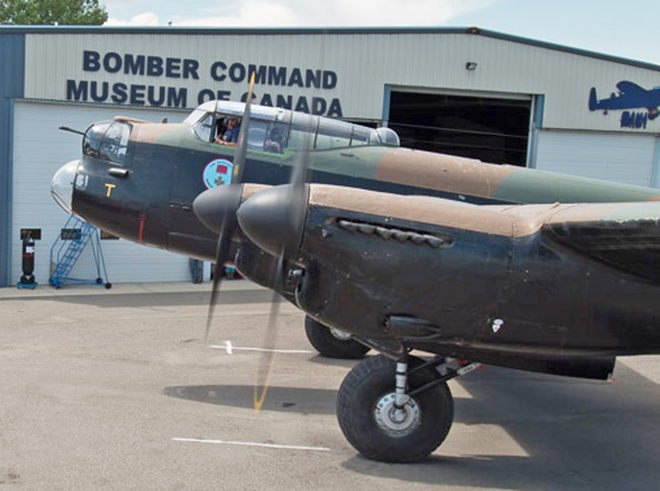 Lancaster
Lancaster  |
Media
|
Media
 Lancaster
Lancaster  |
Media
|
Media
Lancaster FM159 Chronicles
Lancaster FM159
When the Nanton Lancaster Society was formed in 1986, even the idea of having a museum building large enough to house the bomber seemed pretty far-fetched for an all volunteer group in a town of less than 2000 people. However the ambition to make the Merlins run was there from the beginning. In the society's first newsletter published in the Spring of 1987, the restoration committee referred to its goal of taking the restoration to, "the DYNAMIC taxiable exhibit stage."
|
Without a building or any other aircraft and very few artifacts, there were other museum-building challenges to focus on but the Merlins were not forgotten. The Fall 1988 newsletter reported that, "Engine crew boss Lenard Hoffarth had mated an auto oil pump to an electric drill. This set-up was plumbed into each engine in turn, to force inhibiting oil through all parts of the Merlins, including the propeller hubs. The volunteer crew also removed the valve covers in order to visually monitor the oil reaching this area." As well as ensuring that our aircraft's engines were not deteriorating, the society was scouring southern Alberta for engine parts as it visited farms where Lancasters had been scrapped in the late 1940's and early 1950's. There was no question as to what the parts would be used for some day. |
|
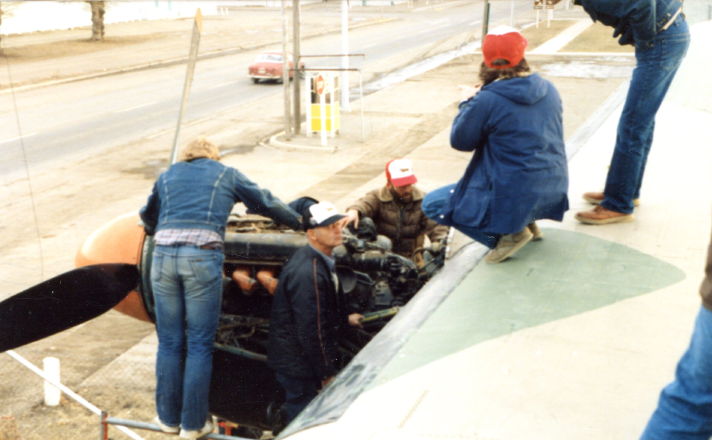
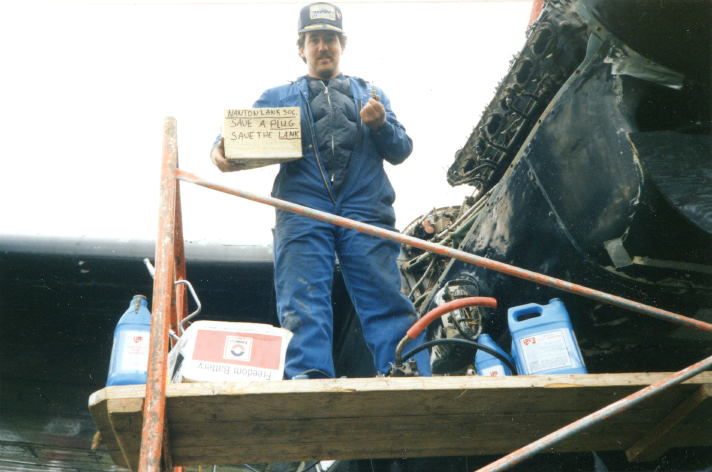
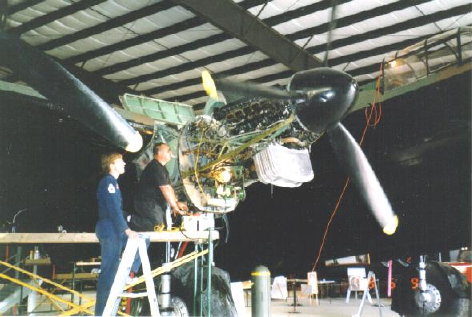 |
Serious efforts towards making the Merlins run began during the summer of 1999. Peter Whitfield and Larry Wright made arrangements for Ian Hickling to inspect Lancaster FM-159, with a particular emphasis on the engines and the possibility of running them. Ian was the AME in charge of Lancaster NX611, a taxiable aircraft based at East Kirkby in England. Ian reported that there were no serious impediments, and encouraged the museum to proceed. During that year, Peter Whitfield spent some time working on #3 and was able to get the engine to turn and the prop to rotate using the starter motor. However, it wasn't until the summer of 2001 that Engine #3 was selected to be the first to run and a team began working regularly towards this goal. As with almost all the projects at the Bomber Command Museum the engine restoration team is all-volunteer, with almost all the work being done on Tuesday evenings. |
The starboard inner was rebuilt starting in September 2001 with a successful run-up in July 2005. The elapsed time was three years and eleven months. The major players during this rebuild were John Phillips (project coordinator), Greg Morrison, Merrill Honeyman, Fred Hollowell, and Gordon Neu. Peter and Paul Whitfield continued to contribute during their regular visits. (l-r) John Phillips, Greg Morrison, Fred Hollowell, Merrill Honeyman. ==> |
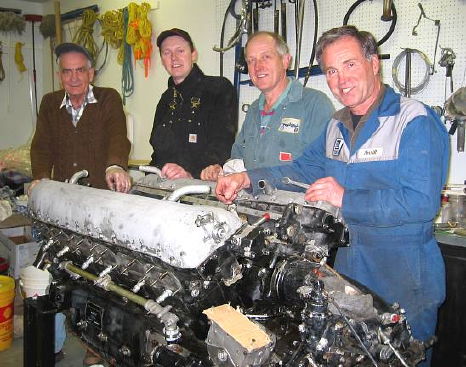
|
Initially during the summer of 2001 Merrill Honeyman and Fred Hollowell along with Greg Morrison's advice started working on the electrical system by tracing each wire from junction box 11 just in front of the engineer's panel. This turned out to be very tedious to say the least and we were glad to have John Phillips joined us around September 2001. John's plan was to work only on those electrical systems/wires that were directly related to the number 3 engine. Peter and Paul Whitfield from Sarnia who had previously visited Nanton to help on miscellaneous Lancaster repairs were helpful with their email suggestions as well. A lot of time during this period was spent in a cold cockpit joining cut wires and labeling them.
The instrument panel was rebuilt and installed and all wiring to the engine traced and tested. The flight engineers panel was also rewired at the same time. The fuse panel was wired but only for those circuits that would have power and a separate breaker box was installed between the batteries and the fuse panel for safety reasons. Radiators for engines 3 & 4 were removed and repaired as well as the oil coolers. The carburetor was sent out for overhaul.
Valve covers and cam train removed. Heads removed and send out for cleaning and valve grinding. John Phillips decided to take a break from July to September and rest in the hospital for a few months. Engine removed from Lancaster. Seals and gaskets ordered. Exhaust stacks cleaned and new locking nuts made.
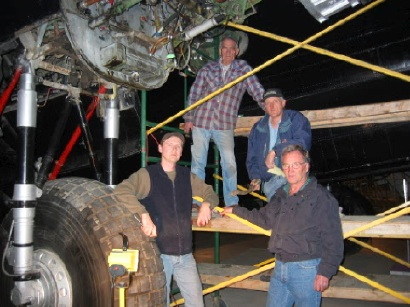 Fred Hollowell, Merrill Honeyman. |
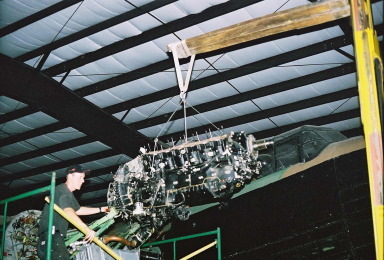 |
Heads put back on as well as camshaft. New 100 weight oil purchased and hot oil pumped through the system. Water pump repaired. In July the rebuilt prop arrives. On Wed Jul 20 we had our first engine test. A few adjustments to the timing and final public run up occurred in August after the engine had sat idle for over 50 years.
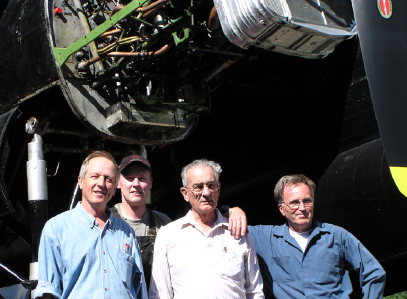 Greg Morrison, John Phillips, Merrill Honeyman. |
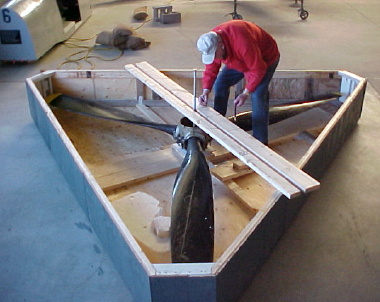 |
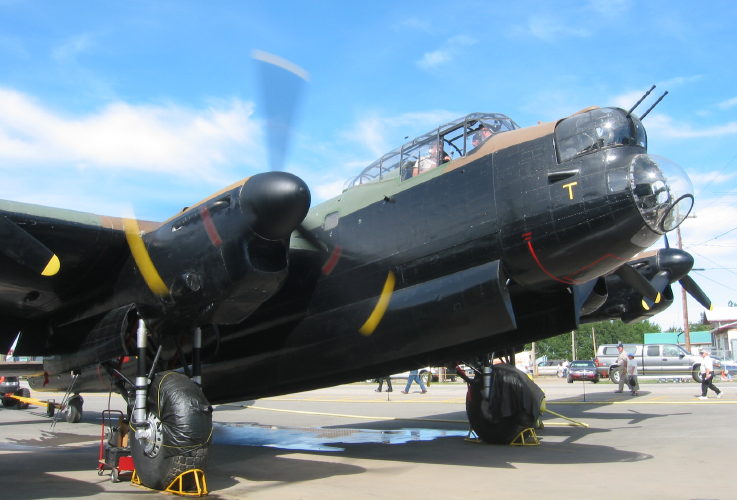
The starboard outer was rebuilt starting in January 2006 with a successful run-up in August 2008. The elapsed time was two years and eight months. Additional key players during this rebuild were Brian Taylor, Dan Hawken, and Shane Chipchase.
Initially the carburetor, spinner, hub, propeller, radiator and oil cooler were removed while the engine was still on the airplane frame. The radiator was sent out for pressure testing and the carburetor was overhauled with particular attention to the adapter (accelerator pump). The prop was sent out to Calgary for rebuilding. Electrical work in the cockpit re number 4 gauges was started. Most of the wiring was in place when we wired up for #3 but still plenty to complete for #4 including instrument panel gauges. The engine was shampooed. We then removed the valve covers, removed all outside coolant lines, the camshaft, primer lines, the intake manifolds and the "log" and then the heads and cylinder blocks. The valves were removed and reground in our shop. Meanwhile we had ordered from California numerous gaskets, filters and seals as well as new cylinder and oil rings. The cylinder block was sent out to be honed and cleaned.
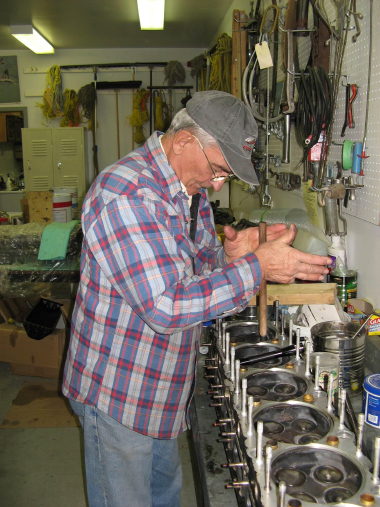 |
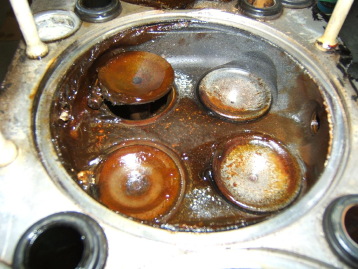 Exhaust stack bolt caught under one of the Merlin valves. 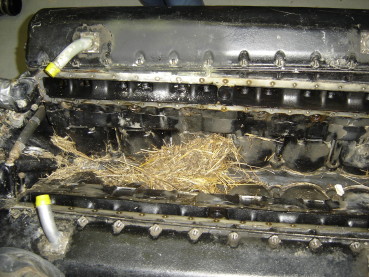 Straw found under the intake "log" after the engine was shampooed. |
The pistons and bushings were removed and serviced with new cylinder and oil rings. We reinstalled the cylinder blocks, heads and camshaft. We retimed ignition and valves. The supercharger was taken apart since we had a shudder when hand cranking the engine. We cleaned and repaired the spinner. Everything was torqued back in place as per manufacturer specs. A lot of time was spent analyzing the supercharger re the shudder. The shudder turned out to be a noise coming from the starter motor. Once the supercharger was replaced we again retimed the magnetos. Meanwhile the water pump was removed and checked for leaks and wear. The intake manifolds were reinstalled along with the "log". The coolant tubes and primer lines were reinstalled. The wiring harness was added. At this point we pressure tested the primer lines and fixed any leaks. The header tank was installed with the new straps made in Windsor. The oil lines had hot oil run through them.
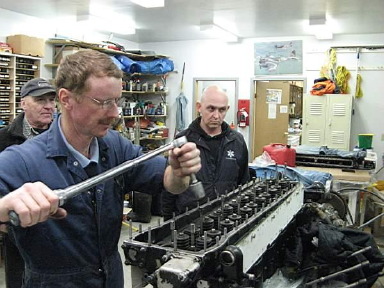 |
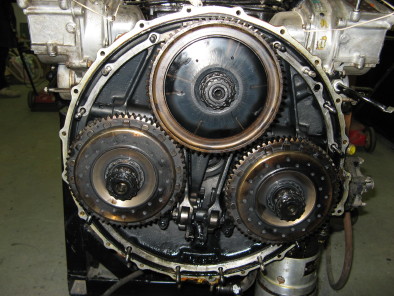 |
Exhaust stacks were repaired. We cleaned out the oil tank. We refitted gas lines and primer lines including testing all electrical required for the new electrical primer panel. The engine was then remounted and then we reinstalled the radiator and oil coolant tanks. All hoses for oil lines and coolant lines were connected. The prop was remounted. We started the engine Thursday Aug 7, 2008.
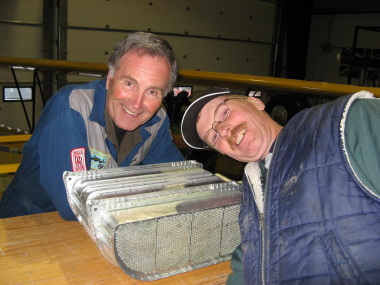 |
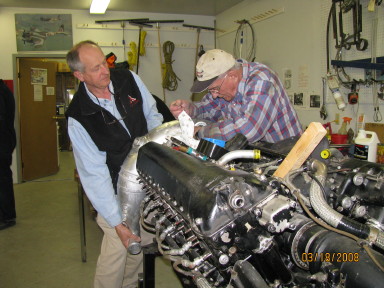 |
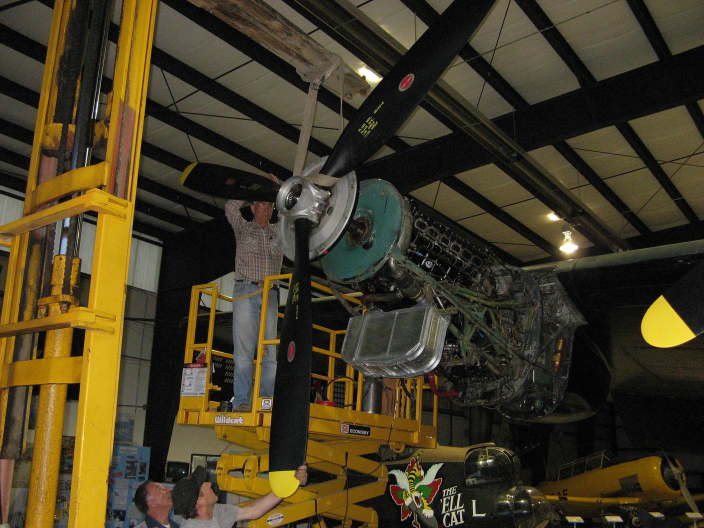
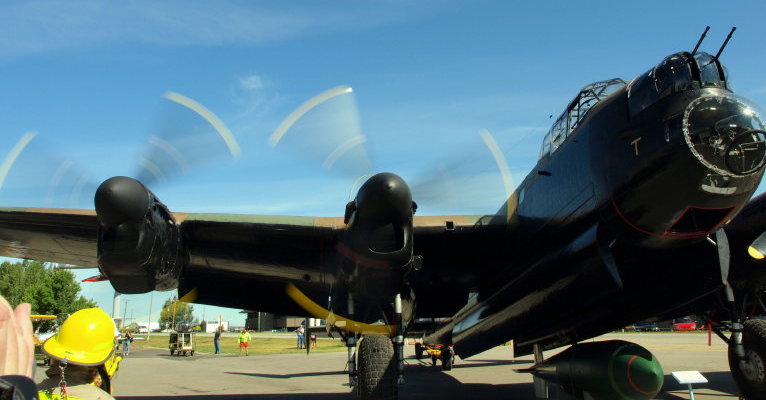
On Feb 10th 2009 we began our work on the restoration of the #2 Lancaster Merlin Engine. We started by replacing the cross over fuel line. We will have to repair a fuel leak at the main crossover valve. The cowls were removed and we documented some missing parts - namely the accelerator pump, fuel pump, throttle linkage, by pass radiator hose and the tach generator. The hub was removed as well as the propeller. Next we removed the exhaust stacks and covers. The carburetor intake was removed to allow for easy removal of the engine and frame together. We loosened up the #1 and #2 fuel cocks. All electrical and oil lines etc were disconnected from the firewall. Then on Tuesday April 21 we removed the complete engine, frame, radiator, carb etc all at once by the removal of just 4 mounting bolts. The complete engine and frame is now mounted in the newly made frame constructed by Dan Hawken.
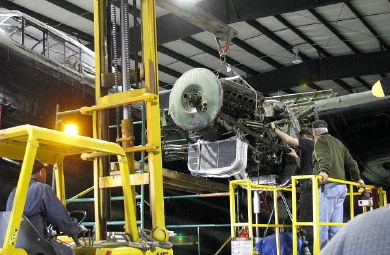
|
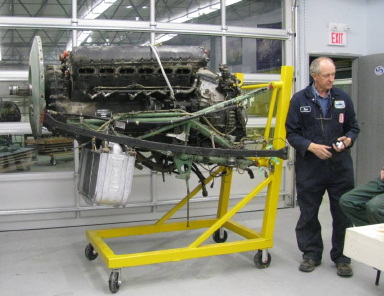
|
Since the removal of the engine last April 21st, 2009 we have continued on preparation work for the running of our third Lancaster Merlin engine. Various components of the engine were stripped off such as the fire extinguisher lines, miscellaneous hoses etc. The engine was then power washed to remove as much as possible the grease and straw that has gathered over the years. The carburetor and radiator were removed and inspected. We then left the Merlin in the shop while we concentrated on all other components on the airframe required to run the engine. As well, over the winter we have done maintenance as required on number 3 and 4 engines - spark plug cleaning, checking oil filters, replacing leaking water pumps etc.
We have decided that before any work is done on overhauling number 2 engine that all electrical wiring, fuel connections, gauges etc. will be completed for both number one and number two engines. It is much easier to do both at once while you have all the diagrams in front of you. Continuity and voltage testing was done for number 1 and 2 engines. All circuits have now been tested for oil, temperature, magnetos, rpm, etc. The instrument panel is now remounted. The fuel cross-over valve was overhauled and re-installed. The tach generators and drive cables have been overhauled and re-installed. We have also connected the circuit for the landings lights and adjusted critical contacts. The pneumatic brake lines for the Lancaster have been reconnected and are now in working order and fully connected to the steering yoke hand lever. The Heywood air compressor for the pneumatic system has been mounted on # 4 engine.
Another area we are currently working on is the hydraulic lines to enable us to open and close the bomb bay doors as well as the flaps. The hydraulic circuits for flaps and bomb bay doors have been isolated from the fuel jettison, carburetor heaters and under carriage circuits. All plumbing is now completed including the overhauling and re-mounting of the hydraulic pump onto number 3 engine. We have also completed mounting of the DC generator and connected all the wiring to make the generator functional. The propeller has been sent to Winnipeg for overhaul.
A lot has happened over the last year thanks to our mild winter. This summer we will be concentrating on the overhaul of number 2 engine.
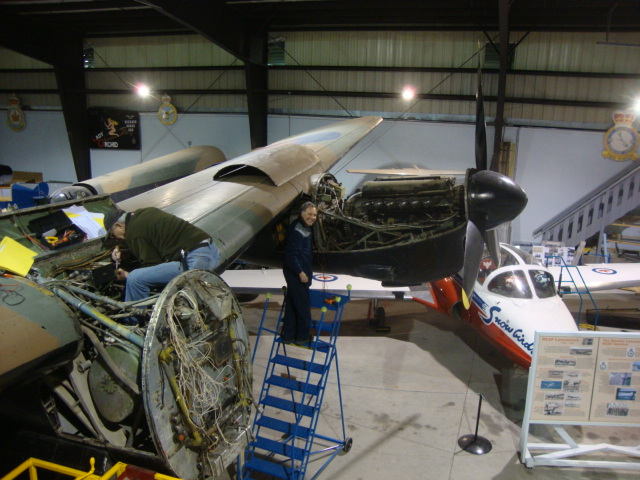
Work has been continuing over the last year and a half with great progress on the number 2 engine. The engine was disassembled systematically - valve covers, intake manifold, intake log, camshafts, starter motor etc. down to the point where the block and heads were sent out at the beginning of August 2010 to Stauffers for cleaning. At the same time the hydraulic components of the Lancaster were completed. Each engine run up now has a showing of the working flaps and the opening and closing of the bomb bay doors. Much work was required to overhaul and change the hoses and seals on all hydraulic rams running the bomb bay doors.
The connecting cables to the main Distribution Panel were reworked. They had been cut off by vandals and required an 18" extension, 33 solder connections and 33 in-line splices. Once the heads were cleaned and the cylinders honed progress was made on the valves - lapping was done by hand and all valves were tested for leaks. The coolant ports were cleaned. We are now into September of 2010. Repairs were made to the junction boxes and wiring for the Lancaster's internal lighting system.
Safety and cross training for the Lancaster engine crew was begun with some in house overhead training sessions. All crew members will be trained on all components for maintaining and running the Lancaster Merlin engines. This is an on going process and will continue formally for the next few years.
Once the engine was re assembled the magneto and valve timing was completed to the satisfaction of everyone. Most components were put back on the engine excepting some of the fire lines which we are not re using on any of the running engines. The carburetor and the water pump were both sent down to California for proper overhauling as we do not have the proper test facilities for such work. The radiator and oil cooler have been re installed (Mar 2011) while engine number 2 is still on the 4 bold mounting stand.
Maintenance is now a large item for the Merlin engine crew with two running engines. Once we have three engines this will become an even bigger chore. We completed all the wiring required for number 2 as well as set up the cross over line required for the priming pump for number 2 engine. All fuel will continue to come from number 2 starboard fuel tank for the running of all four Merlin engines.
As of August 9 2011 we remounted the number 2 engine back onto the Lancaster and are now completing the wiring hookups, coolant and oil line hookups as well as the exhaust stacks and many other minor details. There is still a lot of work to complete before engine startup on this latest engine. The carburetors and water pump and prop overall are still to be completed.
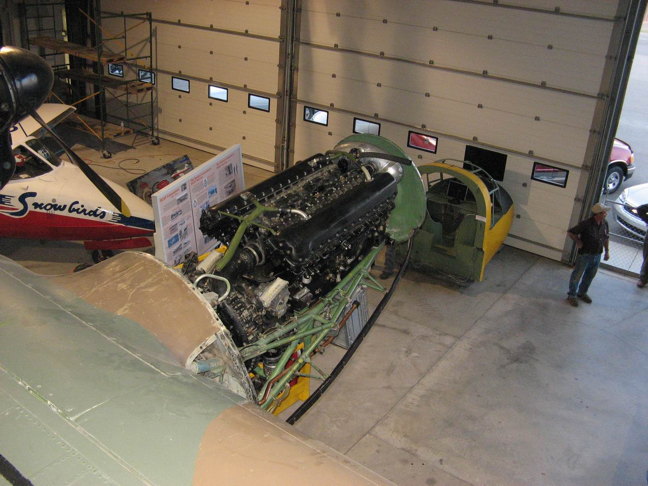
We are now working on #1 port outer engine as we complete the final firewall hookups for #2 port inner. Our first task was to remove the radiator and oil cooler from #1. This was done near the end of August 2011. The oil tank connections were overhauled to ensure there were no leaks. As we began work on #1 we also continued our regular maintenance of #3, & 4 - spark plug removal and cleaning etc.
On October 11, 2011 we removed the #1 propeller - this propeller as of the summer of 2012 has now been delivered to Calgary where it will be overhauled locally. The complete #1 engine was removed on October 25 and rolled over to our maintenance shop where the overhaul is to begin. The extra paraphernalia such as the fire extinguisher lines were removed and the engine cleaned up as much as possible.
On Dec 6th we removed the "B" bank - head and cylinder block. Christmas was close so we took a break until Jan10th and at this point "A" bank was also removed. We then proceeded to clean the camshaft in our new cleaning tank - we also cleaned up the two "banks" - these were then shipped off to Stauffer's for cleaning and honing.
Meanwhile we continued work on #2 by testing the fuel and oil circuits. We did have a few leaks but they were repaired and re-tested. The #2 propeller is still in Winnipeg being overhauled - further testing will be completed when this prop is back - apparently there were some corrosion issues on the blades themselves.
During February 2012 we began the tedious task of lapping the valves by hand of #1 and ensuring there were no leaks once re-installed - this continued on into the summer months. The fuel pump has been replaced by an overhauled one. John P. has mounted a new spark igniter/boost coil for #2 engine. The exhaust covers for #2 were glass beaded and put back on the engine as well as the exhaust stacks. At this point we realized it was time for a complete inventory check for all gaskets and seals we would need for #1 - this has been completed and nicely documented. After one of our monthly run ups we realized we had a leak in the propeller area on #4 - this was repaired quickly.
At the end of August the "A" and "B" banks came back nicely cleaned painted and honed from Stauffers. The fuel lines running from the crossover valve were removed and are currently being re-installed with new hoses. The pistons and wrist pin bushings have been removed and cleaned. The oil tank for #1 has been cleaned with solvent. The oil filters on #1 were not sealing properly so parts from the donor engine were used to fix this problem.
We are now about to place the two banks back onto #1 engine with the hope that next summer 2013 we will have both props returned and have a successful run up of both #1 and #2 engines along with of course #3 and #4.
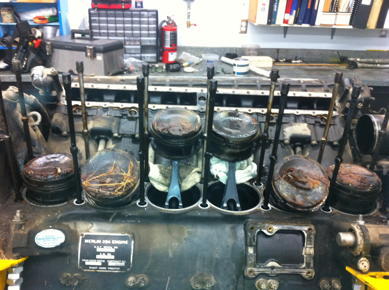 |
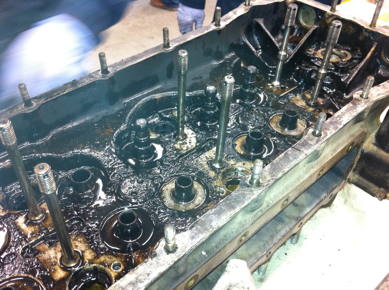 |
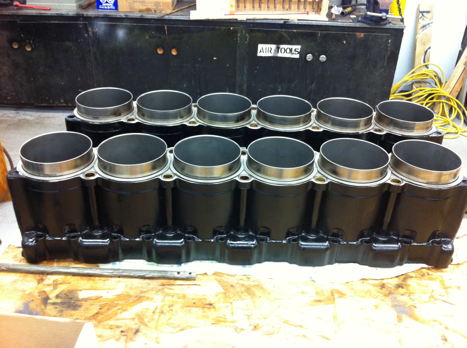
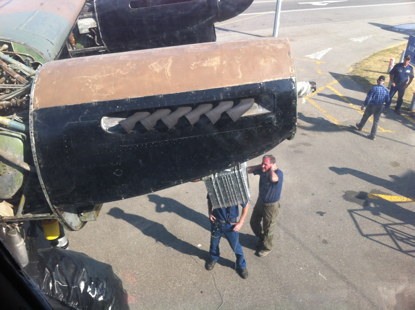 |
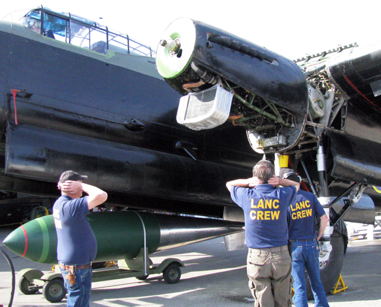 |
On August 17 2013, eighteen years and several thousands of volunteer hours after Peter Whitfield first began the restoration of the engines, the roar of four Merlins was heard on the tarmac of the Bomber Command Museum of Canada.
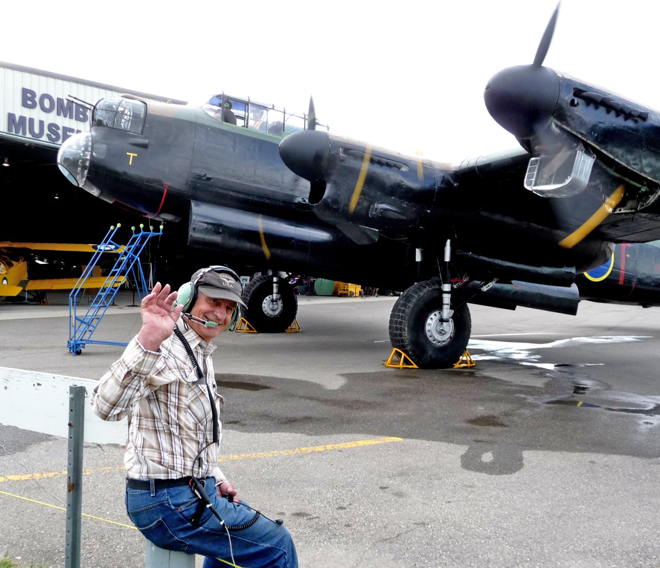
And then, on April 22 2014, FM159's four Merlins were started as, by now, they had been several times before. But this time there were no chocks or brakes holding her back and FM159 taxied for the first time since she was parked on the tarmac at the old Vulcan Aerodrome in 1959.
